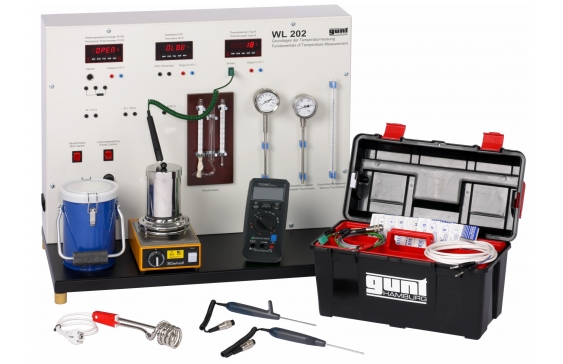WL 202 Fundamentals of temperature measurement

Recording temperature is one of the basic tasks in metrology. Electric temperature sensors are the most widely used in automation applications but conventional thermometer types are still widely applied in many areas. The WL 202 experimental setup covers the full range of temperature measurement methods. As well as non-electrical measuring methods, such as gas- and liquid-filled thermometers and bimetallic thermometers, all typical electric measuring methods are covered in the experiments. The electrically measured temperatures are displayed directly on programmable digital displays. A temperature-proportionate output voltage signal (0…10V) is accessible from lab jacks, enabling temperature characteristics to be recorded with, for example, a plotter. For measuring the relative air humidity a psychrometer with two thermometers is available, one of the thermometers measures the dry bulb. The wet bulb thermometer is covered in a wet cotton cloth and measures the evaporative cooling. The temperature difference allows the relative air humidity to be determined.
A digital multimeter with precision resistors is used to calibrate the electrical measuring devices. Various heat sources or storage units (immersion heater, vacuum flask and laboratory heater) permit relevant temperature ranges to be achieved for the sensors being tested. A tool box houses the sensors, cables, temperature measuring strips and immersion heater.
- experimental introduction to temperature measurement: methods, areas of application, characteristics
- clearly laid out unit primarily for laboratory experiments, also suitable for demonstration purposes
Immersion heater
- power output: 300W
- adjustment of power feed via power-regulated socket
Laboratory heater with thermostat
- power output: 450W
- max. temperature: 425°C
Vacuum flask: 1L
Measuring ranges
- resistance temperature detector Pt100: 0…100°C
- thermocouple type K: 0…1000°C
- thermistor (NTC): 20…55°C
- liquid thermometer: -10…250°C
- bimetallic, gas pressure thermometer: 0…200°C
- temperature measuring strips: 29…290°C
Precision resistors: 10 Ω, 100 Ω, 1000 Ω
Psychrometer
- 2x temperature: 0…60°C
- rel. humidity: 3…96%
230V, 50Hz, 1 phase
230V, 60Hz, 1 phase; 120V, 60Hz, 1 phase
UL/CSA optional
- experiments in the fundamentals of temperature measurement with 7 typical measuring devices
- various heat sources or storage units: laboratory heater, immersion heater, vacuum flask
- calibration units: precision resistors and digital multimeter
- liquid, bimetallic and gas pressure thermometers
- temperature sensors: Pt100, thermocouple type K, thermistor (NTC)
- various temperature measuring strips
- psychrometer for humidity measurement
- tool case for sensors, cables, measuring strips and immersion heater
- learning the fundamentals of temperature measurement by experimentation
- familiarisation with the various methods, their areas of application and special features
- non-electrical methods: gas- and liquid-filled thermometers, bimetallic thermometers and temperature measuring strips
- electric methods: thermocouple, resistance temperature detector Pt100, thermistor (NTC)
- determining air humidity with a psychrometer
- calibrating electric temperature sensors
